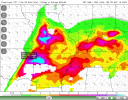Found some analogs for tomorrow from my sounding collection. It seems a lot of the soundings we've been pulling a reminiscent of a classic Kansas outbreak.
May 4, 2003: Girard / Liberal / Stockton & Carl Junction & Pierce City Missouri
Numerous high-end, large, long track tornadoes. Out of an outbreak of 15 total tornadoes, 4 were rated F3 and one an F4. Some tracked for 20-80 miles.
View attachment 41521
June 9, 2005: Hill City, Kansas
Cyclic tornadic supercell (up to F2).
View attachment 41522
May 25, 2008: Parkersburg, Iowa
Long-tracked EF5 wedge tornado that killed 9 people.
View attachment 41523
May 25, 2012: La Crosse, Kansas
Particularly cyclic supercell that produced several tornadoes, up to EF2, in rapid succession.
View attachment 41524
April 28, 2014: Louisville, Mississippi
Long-tracked EF4 tornado that killed 10 people.
View attachment 41525
May 9, 2016: Katie / Wynnewood / Sulphur, Oklahoma
Two tornadoes, the first a particularly photogenic EF4, and the second an EF3 wedge tornado with winds measured by mobile radar to be over 200 mph.
View attachment 41527
May 21, 2016: Leoti, Kansas
Particularly photogenic, stationary supercell that produced a few brief tornadoes.
View attachment 41528
May 24, 2016: Minneola / Dodge City, Kansas
Prolific tornadic supercell producing 13 often-photogenic tornadoes (up to EF3), with three documented simultaneously, in a localized area. Often regarded as one of the greatest days of modern storm chasing.
View attachment 41531
May 4, 2019: Denver City, Texas
Particularly photogenic low-precipitation supercell.
View attachment 41534
June 23 2023 Granada–Holly CO / Johnson KS tornadoes, mothership
View attachment 41535


















